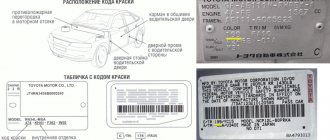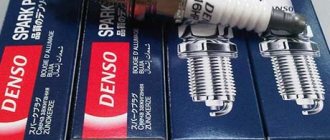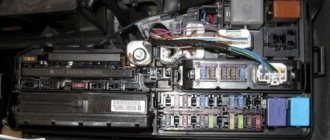Car enthusiasts periodically face situations when the battery is discharged. If you find that there is no charge in the battery on your Toyota Camry, it needs to either be charged or replaced. In the latter case, you should take a responsible approach to choosing a new battery.
How to choose the right battery
Types of batteries by terminal location
For Toyota Camry, Asian standard batteries are used; batteries of the following brands are mainly used: Japanese Panasonic, Yuasa, FB, Varta, including the Korean Rocket. A battery from the Turkish manufacturer Mutlu is also suitable. In some cases, it is possible to install batteries from European manufacturers.
Batteries for Camry come in two different sizes: 261x175x223 mm and 230x175x223 mm for 70 Ah and 60 Ah. The drive is located in the engine compartment at the level of the left headlight. It is worth paying attention to the fact that the car battery on Toyota has a positive polarity (reverse).
You should also choose batteries that were recently manufactured, because even when not in use, the charge weakens. You should not take a battery with a capacity less than the standard one, it is better to install one with a larger one, also with inrush current ratings.
Types of batteries
A good car battery comes with a long warranty, from 3 to 5 years, which speaks volumes about its quality. You should not choose a battery with a shorter warranty period.
What kind of battery is on the Camry XV40
The new Toyota v40 that left the factory has a standard battery from the Japanese manufacturer Panasonic 80D 26L MF.
The standard battery for a Camry 40 with an engine capacity of 2.4 liters has the following indicators: battery capacity – 65Ah, 12V, starting current – 600A, dimensions – 260/173/220.
Recommended batteries for Camry 40 with an engine capacity of 3.5 liters should have the following characteristics and dimensions: capacity - 75Ah, starting current - 650A, dimensions - 261x175x220.
When batteries with smaller battery characteristics are installed in a car, the load on the engine increases. Batteries that are not suitable for the vehicle will shorten its service life.
Battery for XV50
The Toyota Camry v50 with a 3.5 liter engine is equipped with a battery with a capacity of 75Ah and a starting current of 630A.
Good looking
Recommended car batteries for Camry V50 2.0 should have the following characteristics and dimensions: capacity – 70Ah, starting current – 630A, dimensions – 261x175x220.
Drives for Camry V50 2.5 must have the following characteristics and dimensions: capacity – 75Ah, starting current – 700A, dimensions – 260x175x220.
Pay attention to the following battery parameters:
- The voltage should be standard and should be 12 volts. Please check this rating before purchasing, the seller can test it with a load fork.
- The battery capacity must be no lower than that of the factory battery. For v50 the capacity should not be lower than 75Ah.
- The starting current must also meet the requirements of this model. Camry requires a battery with at least 600A starting current.
Battery design
Choose a car battery based on the battery parameters that are optimal for your car model.
Energy storage devices with lower performance ratings will reduce the life of your vehicle. And if the characteristics are too high, then it will not only be more expensive, but may also negatively affect the performance of your car.
The most suitable battery for Camry v50 is Totachi 80D26L.
My car has a Tenax battery, what kind do you have?
If this and other recommended batteries are not on sale, select a battery with the seller, based on the nominal parameters required for your car.
Features of battery operation
For a long service life of a car battery, it is necessary to constantly check its condition, recharge it in time and restore the volume of distilled water. As you recharge the battery, you should periodically monitor the charge current; its value should not be higher than the required value, otherwise the active mass of the plates will collapse.
Pulse battery charger
Before the onset of cold weather and frost, it is necessary to charge the battery for 12 hours to prepare it for critical factors.
The most dangerous factor for the energy source is starting the engine at low air temperatures. To reduce damage to your vehicle and its internals, you should:
- Before the onset of cold weather, change summer oil to winter oil. High-quality oil will help protect your car from frost.
- Check in advance and replace the spark plugs in your Toyota with new ones to prevent problems on a frosty winter morning.
- During periods of severe frost, it is better to remove the battery from the car and keep it in a cool place at home.
- Recharge the battery for more than 12 hours in anticipation of cold weather, without waiting for the first frost.
- Check the condition of the fuses, wiring, alternator and starter. Make sure they don't need replacing.
- During frosts, first of all, crank the engine by turning on the starter briefly, and then try to start the engine. Such measures will help lubricate the channels with oil.
Such actions will definitely help to start the engine during frost and maintain the condition of the battery.
Click on the picture to enlarge
If the car battery charging light on a Camry periodically lights up, this may indicate that current is not supplied from the generator to the on-board network and the battery's energy reserve is being consumed.
The calcium battery in a Camry may not be charged properly if there is poor contact in the negative starter wire that goes from the battery to the engine.
Rules for replacing a battery on a Toyota:
- When removing and installing the battery, the door locks may spontaneously lock if the car has an alarm system installed. Therefore, never leave the key in the ignition at this time.
- When removing the battery, you must first remove the negative terminal.
- When removing the battery, all settings are deleted from the on-board computer's memory, so remove it only if necessary.
Briefly about battery operation
During operation, the battery capacity is maintained by a generator working in conjunction with an electronic relay controller. The active mass and electrolyte gradually degrade, which leads to a drop in capacity at low temperatures. The factory does not regulate the service life of the power supply; replacement is required after 3-5 years of vehicle operation. The battery life is affected by the driving mode (for example, during short trips in winter, the battery capacity is not restored, in this case it is necessary to periodically recharge it from an external unit).
At air temperatures below ... -20°C, the fluidity of motor oil decreases and a natural drop in the capacity of chemical batteries occurs. When you try to start the engine, accelerated degradation and chipping of the active mass begins. Impurities settle at the bottom of the case and create bridges between the negative and positive plates, accelerating the self-discharge of the battery.
Additional load is created by elements with damaged insulation (for example, alarm components installed by the owner).
Replacing the battery
When replacing the battery on a Camry, you must follow these steps:
- Stop the engine, set the parking brake and open the hood.
- Loosen the terminal on the negative pole (using a 10mm hex wrench) and remove the wire.
- Disable the plus; on later generation machines, the Intelligent Battery Sensor (IBS) charging control system unit is located at the terminal. The controller must be removed together with the terminal from the contact pin and moved to the side.
- Unscrew the pressure plate nut and remove the bracket.
- Remove the battery using the handle located on the case.
- Clean the cable clamps from dirt and traces of oxides.
- Wipe the area free of dirt, and if traces of electrolyte are found, deactivate the acid with a soda solution.
- Place the battery case on the standard platform and install the clamping bar. Do not over-tighten the nut as this may damage the plastic casing of the battery.
- Remove the shipping caps from the terminals.
- Install the positive cable of the on-board network, treat the terminal with a special lubricant that prevents the formation of oxides.
- Connect the negative cord and apply a layer of protective lubricant. If your car has an additional alarm system, open the driver's side door or put the keys with the remote control in your pocket before switching. When power is applied, the siren may be activated or the door locks may be locked.
- Carefully close the hood and test run the power unit.
Actions upon discharge
If the battery capacity drops, you must:
- Open the hood and disconnect the positive wire.
- Disconnect the negative cable and then remove the mounting plate.
- Bring the power source indoors and keep it for 4-6 hours at room temperature.
- Connect the charger with correct polarity. Turn on the unit in automatic mode; when using manual settings, set the current within 10% of the rated capacity. All manipulations are carried out in a ventilated room; if the jars have plugs, they should be unscrewed.
It is not recommended to restore the capacity of the car's power supply, since vapors or splashes of electrolyte fall on the metal elements of the car body. The average charging time for the product is 10-15 hours. If during maintenance there is an increase in the electrolyte temperature to +40°C or higher, then charging should be stopped.
What to do if the battery is dead?
When the battery runs out of energy, it does not necessarily need to be replaced with a new one. Most often, it can be very easily charged from the mains by removing it from the car. It is also worth checking whether all devices are normal and working properly, and do not consume additional current.
If the problem is in the battery, then it needs to be replaced.
It is important to consider the polarity and size of the battery. Having selected and purchased a new battery, you should replace the old one.
The battery is replaced on a Camry as follows:
- First, loosen the terminals; to do this, use a 10mm wrench. Be sure to first remove the negative terminal, and only then the positive one.
- After this you need to remove the clamping bar.
- Then the old battery is removed and a new one is installed.
- After this, the bar is secured.
- When installing, first connect the positive terminal, then the negative one.
- Finally, you need to tighten the contacts.
Lead-acid battery design
When replacing the battery, the automatic control unit remains without power and the stored values and parameters are reset. Later, the new data will be stored in memory, and the car will operate as before. But before this, error signals may be issued. Sometimes the radio is blocked, in which case you will need to enter an activation key to resume its operation.
Summing up
The selection of batteries for the Camry is carried out by the owner, taking into account the manufacturer’s requirements. If the product size is incorrectly selected, the terminals of the standard harnesses do not fit onto the contact pins. If you use a power source with an increased body height, the hood cover may be damaged. When the old battery is disconnected, the settings in the control units are reset, which adapt after 3-4 hours of vehicle operation. Until adaptation occurs, the engine may not operate correctly in idle mode and an error indication may appear on the instrument panel.
Main reasons for lack of charge
The main reasons for the lack of charge on the Toyota Camry battery include:
- The most common reason may be that the battery has exhausted its potential resources. This happens after 4 or 5 years of use.
- Due to faulty wiring, the generator may not charge the battery during a trip, which will lead to the battery draining quickly.
- Perhaps due to problems there is a current leak in the on-board network. This can also be indicated by the charging light coming on.
- Rapid battery discharge is possible when you use the headlights or radio with the engine turned off, or forget to turn it off after a trip for a long time.
- If you do not prepare the battery for frost, when exposed to it (critically low temperatures), the battery may discharge.
Signs of an unsuitable battery
If factory recommendations are violated, the battery case does not enter the installation site. The cable length is designed for a casing height of up to 225 mm; with an increased value, the terminals will not fit onto the contact pins. A product with straight polarity fits into its standard place, but it is impossible to connect the unit to the on-board network. When using equipment with reduced capacity or low current, the degradation of the electrolyte and active mass accelerates during cranking, and the battery fails after 1-2 years of operation.











